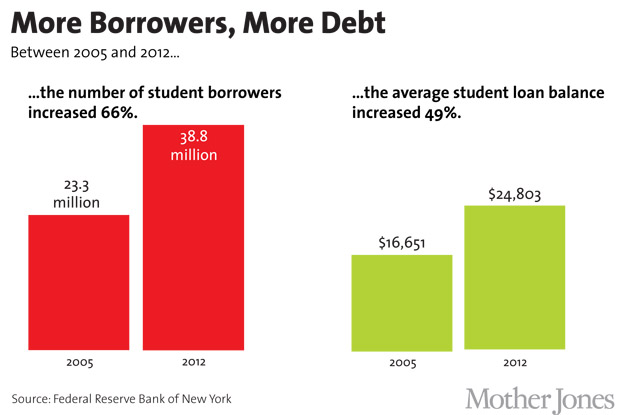Update (6/29/2013): Congress didn’t even come close to agreeing on new student loan rates, so interest rates doubled July 1 for students taking out one common federal loan. After the July 4 recess and before most students take out new loans for college in August, Congress will have a window to fix the loan rate. Senate Democrats are now pushing for a temporary fix, a one-year extension of the low 3.4 percent interest rate that would give Congress time to hammer out a long-term solution. According to the Hill, they have scheduled a vote on the proposal for July 10, though others (including House Republicans and even some fellow Democrats in the Senate) may not be on board.
Got student loans? You are far from alone: More than 38 million Americans have outstanding student loan debt totaling nearly $1 trillion, and those numbers are rising fast. This month, Congress will consider proposals to keep the interest rates on direct federal student loans down. (If it doesn’t act by July 1, the rate for one kind of loan will double from 3.4 percent to 6.8 percent.) Regardless of what lawmakers do, many students and graduates will still have to take on large amounts of debt to pay for college.
Below are nine charts that help illustrate that the student loan crisis isn’t just about interest rates but about how the cost of college has spiraled beyond the reach of many families and is leaving millions of students and grads with debts that are keeping them from realizing their financial goals.
The amount of total student loan debt has soared in the past decade, shooting up from $240 billion at the start of 2003 to nearly $1 trillion today.

That’s the big picture. But why has the total amount of outstanding debt gone up so sharply? One big reason is that higher education, especially at four-year colleges, costs a lot more than it used to.

Inflation isn’t solely to blame. Compared to the overall price of consumer goods, college prices have still risen sharply since 1980.

The rising price of college has contributed to overall student loan debt, but so has the fact that more students are attending college. As more students attend college, they’re taking out more loans—and bigger loans, too.

Mortgage debt is still by far the biggest category of debt in the United States, totaling over $7 trillion. But as more people have invested in college, the total amount of outstanding student loan debt exceeds auto and credit card debt.

This borrowing is hitting some Americans harder than others. Low-income parents report they are less likely to know how they will pay for their children’s college education.

And less wealthy households are shouldering a much larger share of the debt burden. In 2010, almost 60 percent of the nation’s student loan debt was held by households with less than $8,500 in net worth.

Student loans are now more likely to be delinquent than other major types of debt. Currently, 11 percent of student loan balances have gone unpaid for more than 90 days. That’s a low-ball estimate: The Federal Reserve Bank of New York guesses that, if you exclude borrowers that have deferred their loan payments, the share of delinquent borrowers would be more than 20 percent.

Even when students pay back their loans on a standard, 10-year repayment plan, the interest does add up. The current proposals for changing interest rates on some federal loans could have a big impact on borrowers. Keep in mind that the loans that Congress is discussing right now have some of the lower rates of the student loans out there: Federal loans for parents and grad students have higher interest rates than the rates below.

The silver lining to this story is that more Americans are pursuing higher education, even if they are taking out loans to do so. Some economists are troubled by the fact that fewer people under 30 are buying homes and other goods as more are paying for college, but higher education is, on the whole, a solid place to put your money. In 2010, the median earnings for young adults with bachelors degrees were 50 percent higher than those of their counterparts with high school diplomas. But for many members of Generation Debt, the benefits of having a diploma may seem a long way off.















